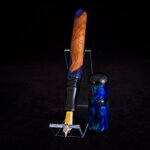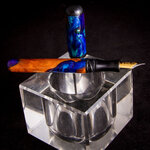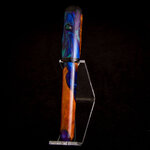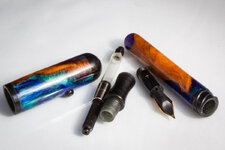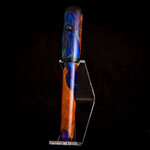You are using an out of date browser. It may not display this or other websites correctly.
You should upgrade or use an alternative browser.
You should upgrade or use an alternative browser.
Custom worthless wood fountain pen
- Thread starter budnder
- Start date
Signed-In Members Don't See This Ad
See more from budnder
It's one piece - same material as the other black resin pieces. It's a mix of Siraya Tenacious and Elegoo Black. It just appears a different color because I didn't finish it and probably also because it's a little thinner on that back end, so is slightly translucent.
I think it'll wear fine, but we'll see. I've played with it a lot already and I don't notice any change. It's got a different feel to it than traditional threads, which I'm ok with, as I was going for the look and aggressive travel rather than the feel. The thread is a triple start 2 TPI, so it typically takes a portion of a revolution to close it. The threads are round - neither imperial or ACME

Just based on my experiments and not on any specific science knowledge I have... I think the "edge" of a SLA resin part has lots of peaks and valleys where the resin randomly did or didn't cure. The transition between cured and uncured resin is not perfect at the micro layer. That's where the chalkiness comes from - when you have friction, you're breaking off the tops of those peaks. When you get the transition edge smooth, it stops being chalky. So you have two choices, you either knock the micro peaks down by polishing them, or you fill in the valleys with something. I polished all the parts, save for the external thread bit on the body, because I couldn't figure out a good way of really getting the sides of the threads to polish to my satisfaction. For that part, I coated it with thin Solarez to fill in the "micro valleys". So I think the chalkiness isn't inherent, but rather about excessive friction. That's my theory based on what I experienced, anyway.
Incidentally, I also tried just using Elegoo resin to smooth out the finished part, as I know some 3D print folks do that. I found it too thick for what I wanted. I probably could have used thin CA instead, but it sets too quickly for my comfort. I also used the Solarez to dome the inlay in the roll stop. I know some time back TonyL did a bunch of experiments using Solarez as a CA alternative... I need to go back and review what he did as I'm now kind of curious if some sort of dipping finish might be possible with one of the Solarez varietys. I've always hoped to find a finish CA/Resin finish technique that didn't require sanding and polishing. Currently, my finishing process (CA and sanding/polishing) takes longer than any other step in making a pen. I did a bunch of experiments last year with an auto clear coat and just couldn't get it as smooth and flawless as CA sanded/polished.
They've really gotten cheap over the past year or so (mine was like $250). And the new resin based ones have enough precision that you don't get those lines in everything you print. What's not cheap, though, is the learning curve and time suck with all the relatively immature software bits that you have to use to do get something to print. Clearly that's not yet to a point where most would be comfortable. I guess you could sort of say the same thing with CNC routers also. And I guess that's always been said of kitless stuff - 80% of it is done off the lathe beforehand. And patience... I probably went through four iterations on these parts until everything fit like I wanted. Each one of those took 3 hours to print, which means I probably did each one of those on a different day (do the design revisions in the evening and start the print, then check the results the next morning). Oh, and the resin and part cleanup afterwords is supper messy, though does get a bit cleaner after you get the hang of it.
Another thing is that I've been spoiled by all the great people and advice on this forum. I feel like here, there's generally a pretty high standard to what people post, as far as it being good advice and accurate. By comparison, I found the various 3D resin printing communities to have way more flawed advice, flawed experiments, etc.
One cool thing I did that dawned on me midway through this one, was to print some bushings, too. Sometimes I don't use them, but generally I prefer bushings for work holding while I'm turning. I usually just whip up something temporary in maple or aluminum. But it occurred to me that I could just print them along with the parts (head slap)... and they actually worked pretty well. I did both a .25" through hole and a 60 degree cone on the end, and ended up using the 60 degree cone directly on the dead and live center. So add custom, disposable TBC bushings to the list of things you can do with a 3D printer.
Signed-In Members Don't See This Ad
TG Design
Member
Very nice, the cap threads are very cool! Great job!
Sent from my iPhone using Penturners.org mobile app
Sent from my iPhone using Penturners.org mobile app
FGarbrecht
Member
Looks like section and section threading were printed separately (or at least they appear to be different colors (materials)? I assume this is resin printed? Which resin did you choose. Any idea how well the threads will hold up under use?
budnder
Member
Looks like section and section threading were printed separately (or at least they appear to be different colors (materials)? I assume this is resin printed? Which resin did you choose. Any idea how well the threads will hold up under use?
It's one piece - same material as the other black resin pieces. It's a mix of Siraya Tenacious and Elegoo Black. It just appears a different color because I didn't finish it and probably also because it's a little thinner on that back end, so is slightly translucent.
I think it'll wear fine, but we'll see. I've played with it a lot already and I don't notice any change. It's got a different feel to it than traditional threads, which I'm ok with, as I was going for the look and aggressive travel rather than the feel. The thread is a triple start 2 TPI, so it typically takes a portion of a revolution to close it. The threads are round - neither imperial or ACME
PenHog
Member
Really cool pen. I especially like the big threads.
FGarbrecht
Member
I've modeled some threads using Siraya Blu as well as standard Elegoo green. They get 'chalky' and don't hold up well (but your threads are lot more 'chunky' than what I designed). Do you use Fusion360 for your design work? I assume you designed the threads into the print but I suppose you could have machined the threads after printing too. Nice pen BTW....It's one piece - same material as the other black resin pieces. It's a mix of Siraya Tenacious and Elegoo Black. It just appears a different color because I didn't finish it and probably also because it's a little thinner on that back end, so is slightly translucent.
I think it'll wear fine, but we'll see. I've played with it a lot already and I don't notice any change. It's got a different feel to it than traditional threads, which I'm ok with, as I was going for the look and aggressive travel rather than the feel. The thread is a triple start 2 TPI, so it typically takes a portion of a revolution to close it. The threads are round - neither imperial or ACME
budnder
Member
I've modeled some threads using Siraya Blu as well as standard Elegoo green. They get 'chalky' and don't hold up well (but your threads are lot more 'chunky' than what I designed). Do you use Fusion360 for your design work? I assume you designed the threads into the print but I suppose you could have machined the threads after printing too. Nice pen BTW....
Just based on my experiments and not on any specific science knowledge I have... I think the "edge" of a SLA resin part has lots of peaks and valleys where the resin randomly did or didn't cure. The transition between cured and uncured resin is not perfect at the micro layer. That's where the chalkiness comes from - when you have friction, you're breaking off the tops of those peaks. When you get the transition edge smooth, it stops being chalky. So you have two choices, you either knock the micro peaks down by polishing them, or you fill in the valleys with something. I polished all the parts, save for the external thread bit on the body, because I couldn't figure out a good way of really getting the sides of the threads to polish to my satisfaction. For that part, I coated it with thin Solarez to fill in the "micro valleys". So I think the chalkiness isn't inherent, but rather about excessive friction. That's my theory based on what I experienced, anyway.
Incidentally, I also tried just using Elegoo resin to smooth out the finished part, as I know some 3D print folks do that. I found it too thick for what I wanted. I probably could have used thin CA instead, but it sets too quickly for my comfort. I also used the Solarez to dome the inlay in the roll stop. I know some time back TonyL did a bunch of experiments using Solarez as a CA alternative... I need to go back and review what he did as I'm now kind of curious if some sort of dipping finish might be possible with one of the Solarez varietys. I've always hoped to find a finish CA/Resin finish technique that didn't require sanding and polishing. Currently, my finishing process (CA and sanding/polishing) takes longer than any other step in making a pen. I did a bunch of experiments last year with an auto clear coat and just couldn't get it as smooth and flawless as CA sanded/polished.
budnder
Member
Beaut pen, Roy !!
If only Santa had brought me a 3-D printer for Xmas !!!
They've really gotten cheap over the past year or so (mine was like $250). And the new resin based ones have enough precision that you don't get those lines in everything you print. What's not cheap, though, is the learning curve and time suck with all the relatively immature software bits that you have to use to do get something to print. Clearly that's not yet to a point where most would be comfortable. I guess you could sort of say the same thing with CNC routers also. And I guess that's always been said of kitless stuff - 80% of it is done off the lathe beforehand. And patience... I probably went through four iterations on these parts until everything fit like I wanted. Each one of those took 3 hours to print, which means I probably did each one of those on a different day (do the design revisions in the evening and start the print, then check the results the next morning). Oh, and the resin and part cleanup afterwords is supper messy, though does get a bit cleaner after you get the hang of it.
Another thing is that I've been spoiled by all the great people and advice on this forum. I feel like here, there's generally a pretty high standard to what people post, as far as it being good advice and accurate. By comparison, I found the various 3D resin printing communities to have way more flawed advice, flawed experiments, etc.
One cool thing I did that dawned on me midway through this one, was to print some bushings, too. Sometimes I don't use them, but generally I prefer bushings for work holding while I'm turning. I usually just whip up something temporary in maple or aluminum. But it occurred to me that I could just print them along with the parts (head slap)... and they actually worked pretty well. I did both a .25" through hole and a 60 degree cone on the end, and ended up using the 60 degree cone directly on the dead and live center. So add custom, disposable TBC bushings to the list of things you can do with a 3D printer.

